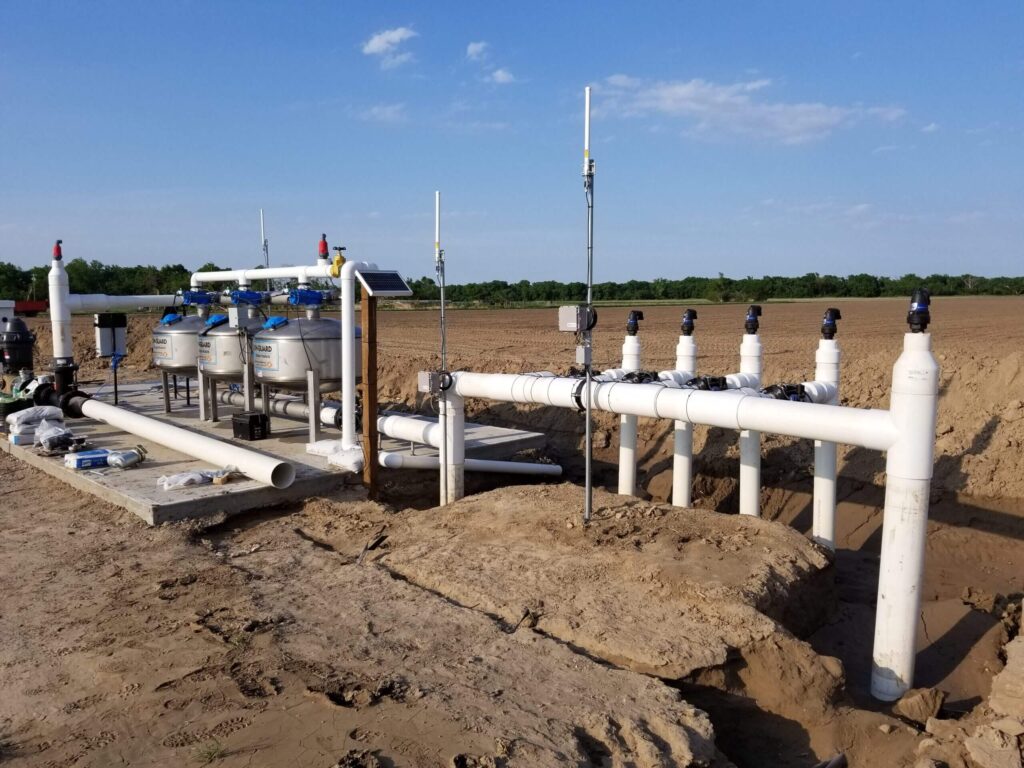Subsurface Drip vs. Traditional Irrigation: A Data-Driven Look at Water Savings
Subsurface Drip vs. Traditional Irrigation: A Data-Driven Look at Water Savings
Water is the lifeblood of agriculture, but its efficient use is more critical than ever. As farmers face mounting pressures from water scarcity and rising operational costs, the irrigation system you choose can make or break your season. The long-standing methods of flood and sprinkler irrigation are being challenged by a more precise and resource-conscious alternative: subsurface drip irrigation.
This article provides a data-driven look at how these irrigation systems compare. We will explore how water use efficiency directly impacts crop yields, operational costs, and long-term sustainability. By understanding the differences, you can make a more informed decision for your farm’s future, ensuring every drop of water contributes to your bottom line and the health of your land.
The Basics of Subsurface Drip and Traditional Irrigation
How Subsurface Drip Works
Subsurface Drip Irrigation (SDI) is an advanced method that delivers water directly to the plant’s root zone through a network of buried driplines. This system is designed for precision, releasing water slowly and uniformly beneath the soil surface. By targeting the roots, SDI ensures that water and nutrients are available exactly where the plant needs them, eliminating surface water loss and promoting optimal growing conditions from below.
Traditional Methods
Traditional irrigation methods, primarily flood (or furrow) and center-pivot sprinkler systems, have been the standard for generations. Flood irrigation involves covering the surface of a field with water, which then seeps into the soil. Sprinkler systems distribute water over the top of the crop canopy, mimicking rainfall.
The Core Difference
The core difference between these approaches lies in the point of application. Traditional systems apply water to the soil surface, exposing it to evaporation from the sun and wind, as well as runoff on uneven terrain. In contrast, subsurface drip irrigation delivers water beneath the surface, directly to the roots.

Measuring Water Use Efficiency
Water Loss Factors
In traditional irrigation systems, a significant portion of water never reaches the crop’s roots. Evaporation is a primary culprit, as water sprayed into the air or pooled on the surface quickly turns to vapor. Runoff occurs when water is applied faster than the soil can absorb it, carrying valuable topsoil and nutrients away. Finally, deep percolation happens when excess water sinks below the root zone, becoming unavailable to the plants and potentially leaching nutrients from the soil.
Root Zone Delivery
Subsurface drip irrigation fundamentally changes the water efficiency equation by minimizing these losses. With water delivered directly to the root zone, surface evaporation is nearly eliminated. Since the water is applied slowly and precisely, runoff becomes a non-issue, even on sloped fields.
Case Study Data
Real-world data from water-limited regions confirms the superior efficiency of SDI. Studies have consistently shown that farms converting from traditional methods to subsurface drip can achieve water savings of 30-50% or more without sacrificing yield. In many cases, yields actually increase due to more consistent moisture and nutrient availability.
Impacts on Soil and Crop Health
Soil Structure Benefits
Because subsurface drip irrigation avoids saturating the soil surface, it helps maintain and improve soil structure. Traditional flood irrigation can lead to soil compaction and surface crusting, which restricts air and water movement. SDI keeps the soil surface dry, reducing compaction from heavy equipment and minimizing soil erosion caused by water runoff.
Crop Stress Reduction
Crops thrive on consistency, and SDI excels at providing a steady supply of moisture directly to the roots. This prevents the “feast or famine” cycle of wet and dry periods common with traditional irrigation, reducing crop stress. With consistent access to water and nutrients, plants can develop stronger root systems and maintain vigorous growth, leading to healthier crops that are more resilient to disease and environmental pressures.
Weed Control
Weeds need water to germinate and grow, and most weed seeds are present in the top layer of the soil. By keeping the soil surface dry, subsurface drip irrigation creates an environment where weeds struggle to sprout. Traditional irrigation methods, which wet the entire surface, inadvertently water weed populations along with the crop.
Financial Implications of Irrigation Choices
Upfront Investment
It is true that the initial installation cost for a subsurface drip irrigation system is typically higher than for traditional flood or sprinkler systems. SDI requires specialized equipment, including driplines, filters, and pumps, as well as a professional design and installation process.
Long-Term Savings
The higher upfront cost of SDI is offset by significant long-term operational savings. Because the system is more efficient, it requires less water, leading to lower water bills or allowing you to irrigate more acreage with the same water allocation. Pumping costs are also reduced, as SDI operates at lower pressures than high-pressure sprinkler systems.
Yield Economics
Perhaps the most compelling financial benefit of subsurface drip is its impact on crop yields. By providing optimal water and nutrient levels, SDI often leads to higher-quality, more uniform, and larger yields. For high-value crops, even a modest increase in production can generate substantial revenue. When you combine increased yields with lower operational costs, the return on investment for an SDI system becomes clear, making it a financially sound decision for the forward-thinking farmer.

Sustainability and Climate Considerations
Drought Adaptation
In an era of increasing climate variability, the ability to adapt to drought is crucial. Subsurface drip irrigation is one of the most effective tools for drought-resilient agriculture. Its high water efficiency allows farmers to produce a crop with significantly less water, making it possible to continue farming even when water allocations are cut.
Groundwater Preservation
Over-extraction of groundwater from aquifers is a major sustainability challenge worldwide. Traditional irrigation methods contribute to this problem by applying more water than is necessary, leading to aquifer depletion. By using water more precisely, subsurface drip irrigation reduces the overall demand on groundwater sources.
Carbon Footprint
The energy required to pump and distribute water is a significant component of a farm’s carbon footprint. Subsurface drip systems typically operate at lower pressures than center-pivot sprinklers, which translates directly to lower energy consumption. By reducing pumping requirements, SDI helps lower greenhouse gas emissions associated with electricity or fuel use.
Technology and Data in Irrigation Decisions
Sensors and Monitoring
Modern irrigation is no longer a guessing game. Integrating soil moisture sensors with a subsurface drip system allows you to monitor conditions in the root zone in real-time. This data empowers you to apply water only when and where it is needed, preventing over-watering and ensuring plants have optimal moisture levels.
Automation Benefits
Automation technology takes the guesswork and manual labor out of irrigation scheduling. Automated SDI systems can be controlled remotely via a smartphone or computer, allowing you to adjust watering schedules based on sensor data or weather forecasts. Some systems can even make predictive adjustments automatically, ensuring your crops receive the perfect amount of water without you ever having to set foot in the field.
Data-Driven Farming
The data collected from sensors and automated systems is invaluable for making strategic farming decisions. By analyzing irrigation metrics alongside yield data, you can identify which practices are most effective and profitable. This data-driven approach allows you to continuously optimize your water use, nutrient application, and overall field management, turning your irrigation system into a powerful tool for business intelligence.
Farmer Experiences and Lessons Learned
Transition Challenges
Adopting any new technology comes with a learning curve, and transitioning to subsurface drip irrigation is no exception. Farmers often face challenges related to the initial system design, understanding maintenance requirements like filter cleaning and line flushing, and adapting their field management practices.
Success Stories
Despite the initial challenges, the success stories are numerous and compelling. Farmers who have made the switch consistently report significant water and energy savings, reduced labor costs, and impressive yield increases. Many highlight the ability to farm difficult or sloped terrain that was unsuitable for traditional irrigation.
Avoiding Mistakes
Common pitfalls in adopting subsurface drip irrigation SDI often stem from improper design or inadequate maintenance. A poorly designed system can result in uneven water distribution, while neglecting maintenance can lead to clogged driplines and system failure. The key to avoiding these mistakes is to partner with a reputable and experienced irrigation provider who can deliver a customized, well-engineered system and provide the guidance needed to operate it effectively.

Western Irrigation’s Approach to Smarter Water Use
Customized Planning
At Western Irrigation, we understand that no two fields are the same. That is why we begin every project with a thorough evaluation of your land, soil type, crop, and water source. Our team works with you to develop a customized irrigation plan that is tailored to your specific needs and goals, ensuring the design balances upfront cost with long-term efficiency and performance.
Advanced Mapping & Design
We use the latest technology to ensure your subsurface drip system is engineered for accuracy. Using GPS mapping, we chart the elevation and terrain of your land to inform our hydraulic modeling. This advanced design process guarantees that every part of your field receives uniform water and pressure, which is essential for achieving consistent crop growth and maximizing your yield potential.
Expert Support
Our commitment to you doesn’t end after installation. Western Irrigation believes in building long-lasting relationships with our customers. We provide expert support and prompt service to help you maximize your water savings and return on investment for years to come. Our team of authorized dealers, designers, and installers has delivered superior service since 1985, and you can rely on us for ongoing guidance and maintenance.
Unlock Your Farm’s Potential
Subsurface drip irrigation is far more than just a new piece of technology—it is a proven strategy for growing more with less. By delivering water directly to the roots, it minimizes waste, improves crop health, and provides a clear financial return. In a world where every drop counts, making the switch to a more efficient system is one of the smartest investments a farmer can make.
Before you invest in your next irrigation system, take the time to review your water use data and explore the potential of SDI. By embracing precision agriculture, you can secure your farm’s profitability and contribute to a future where farming uses less water to grow more food, sustainably. Contact Western Irrigation today to learn how we can help you achieve your goals.
